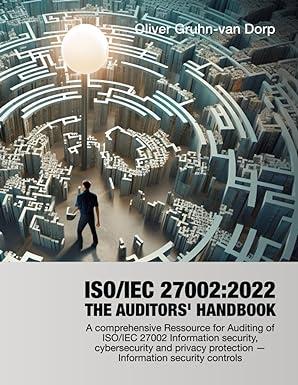Question
Company A leased new equipment from Lessor Corp. on January 1, 2017, for a period of three years. Lease payments of $100,000 are due to
Company A leased new equipment from Lessor Corp. on January 1, 2017, for a period of three years. Lease payments of $100,000 are due to Lessor Corp. each year with the first payment due on January 1, 2017. The annual lease payment includes $2,000 per year designated to cover maintenance costs associated with the equipment. The lease contains no purchase or renewal options and the equipment reverts to Lessor Corp. on the expiration of the lease. The remaining useful life of the equipment is four years. The fair value of the equipment at lease inception is $265,000. Company A has guaranteed $20,000 as the residual value at the end of the lease term. The $20,000 represents the expected value of the leased equipment to the lessee at the end of the lease term. The salvage value of the equipment is expected to be $2,000 after the end of its economic life. The lessees incremental borrowing rate is 11 percent (Lessors implicit rate is 10 percent and is calculable by the lessee from the lease agreement). Company A has not elected to early adopt ASC 842 to account for any of their leases.
The assistant controller of Company A analyzed the assets under lease, determined whether the lease was an operating lease or capital lease, and prepared the applicable journal entries. The controller of Company A reviewed the assistant controllers analysis and prepared a separate analysis. As the CFO, you were given both analysis to determine the correct accounting treatment. Calculations and journal entries performed by the assistant controller and controller are below.
Assistant controller analysis:
Since the equipment reverts to Lessor Corp., it is an operating lease.
Entries to be posted in Years 1, 2, and 3:
Dr. Lease expense $100,000
Dr. Insurance expense $2,000
Cr. Cash $102,000
Controller analysis:
Step 1 Lease classification
The lease term is for three years. The useful life of the equipment is four years. Since the lease term is for a major part of the useful life of the equipment, it is a capital lease.
Step 2 Computation of the lease asset and obligation
Since the lessees incremental borrowing rate is greater than the lessors implicit rate in the lease, compute the present value of the minimum lease payments using the 11 percent rate.
Present value of the minimum lease payments = $100,000 2.4437 = $244,370.
Step 3 Allocation of payments between interest and lease obligation
Since interest must be charged on the straight-line method, the following is the allocation of the interest and the reduction in the lease liability.
Reduction in Balance of
Interest Lease Lease
Year Cash Payment Expense (11%) Obligation Obligation
0 $244,370
1 $100,000 $26,881 $73,119 $171,251
2 $100,000 $26,881 $73,119 $ 98,131
3 $100,000 $26,881 $73,119 $ 25,012
Journal entry in Year 1 to record the payments:
Dr. Rent expense $ 2,000
Dr. Interest expense $26,881
Dr. Lease obligation $73,119
Cr. Cash $102,000
Required:
1. Was the assistant controllers analysis correct? Why or why not?
2. Was the controllers analysis correct? Why or why not?
3. If neither answer is correct, show the correct analysis including all 2017 entries needed to account for this lease.
Be sure to provide appropriate authoritative sources for positions taken.
Step by Step Solution
There are 3 Steps involved in it
Step: 1

Get Instant Access to Expert-Tailored Solutions
See step-by-step solutions with expert insights and AI powered tools for academic success
Step: 2

Step: 3

Ace Your Homework with AI
Get the answers you need in no time with our AI-driven, step-by-step assistance
Get Started


